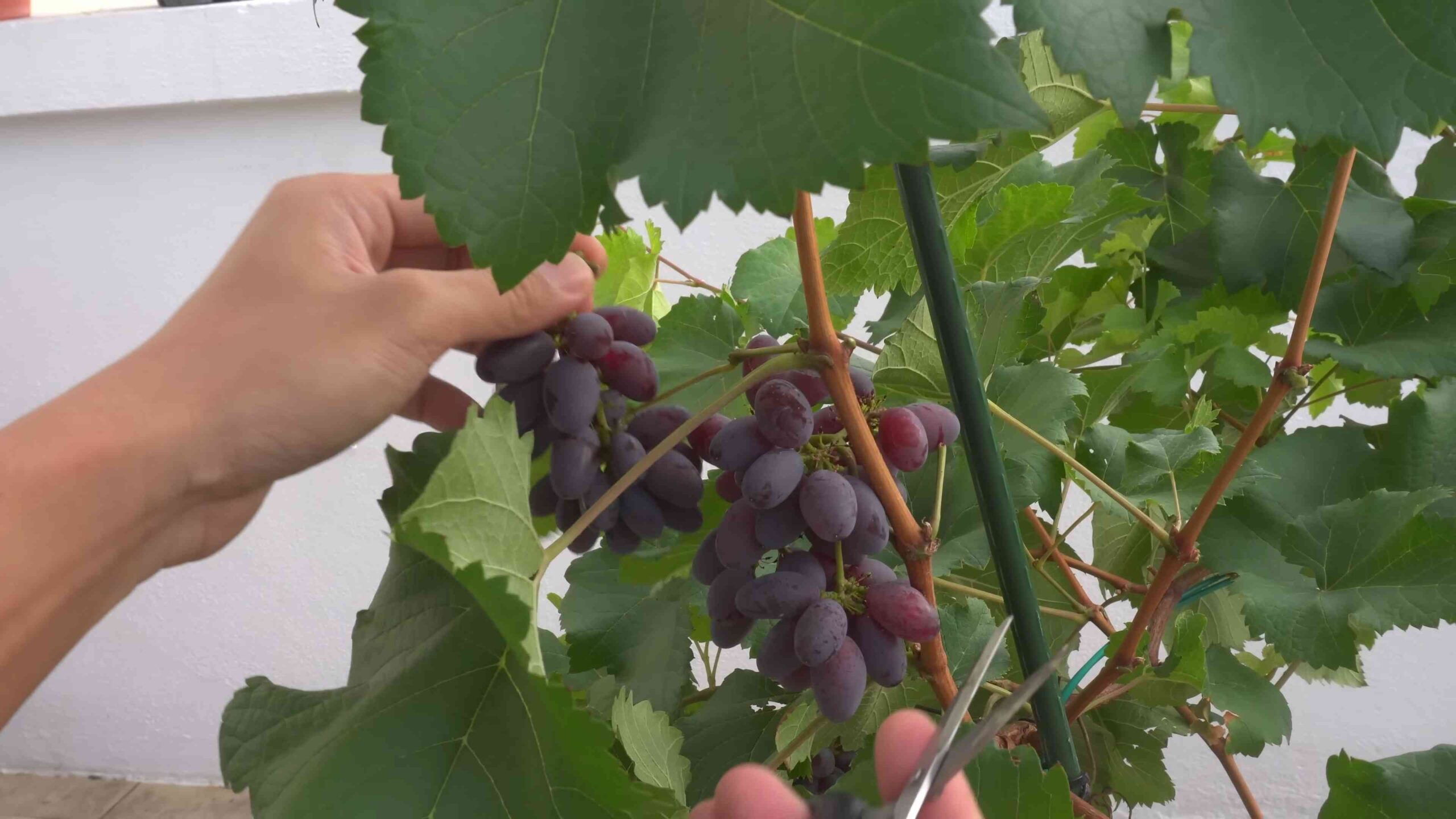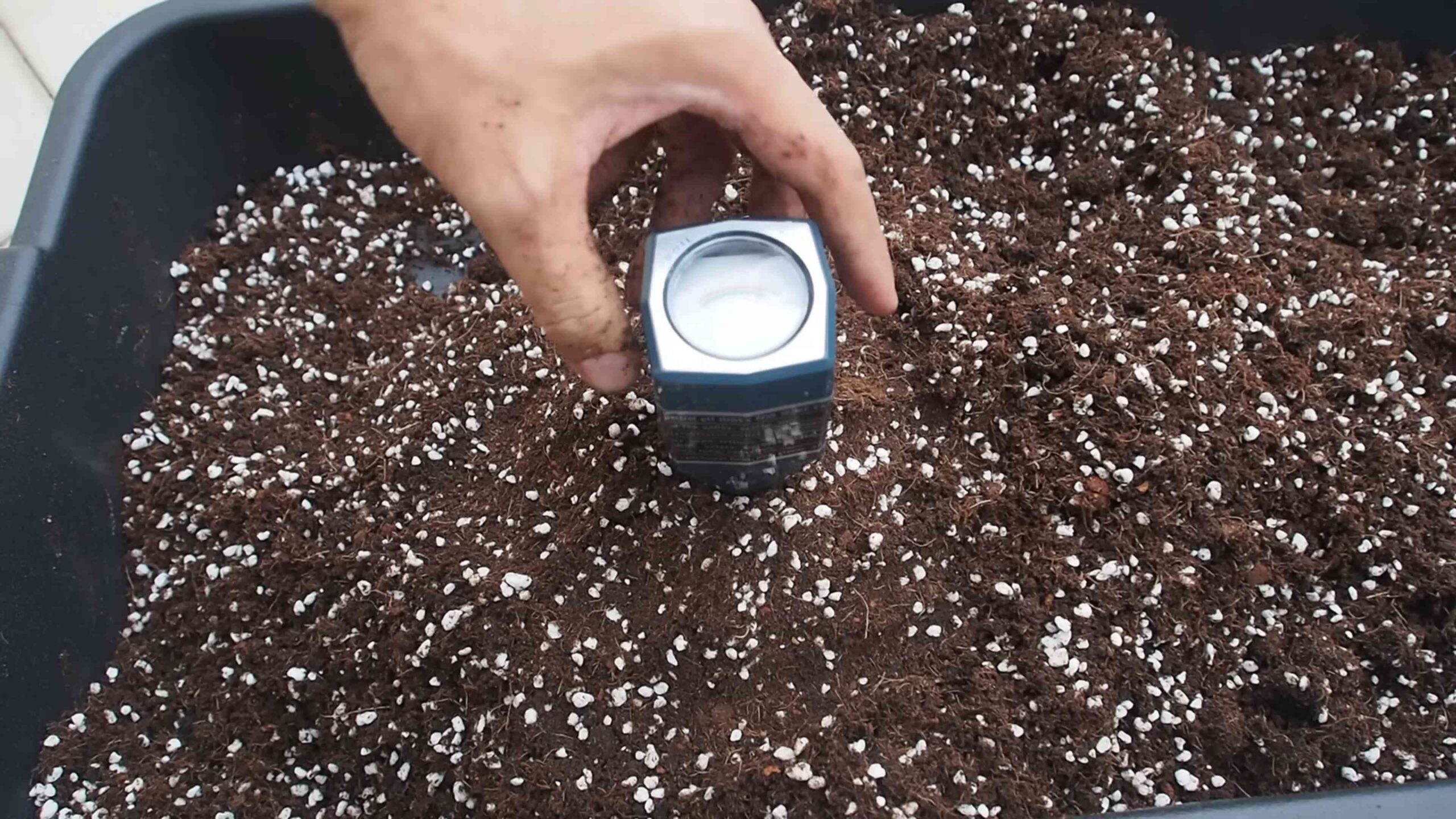Growing Grapes in Pots might seem like a challenge reserved for sprawling vineyards, but I’m here to tell you that delicious, homegrown grapes are absolutely within reach, even if you only have a balcony or small patio! Forget acres of land; with the right know-how, you can cultivate your own miniature vineyard in containers.
For centuries, grapes have been a symbol of abundance, celebration, and even divine inspiration. From ancient Roman feasts to the sun-drenched vineyards of the Mediterranean, grapes have held a special place in human culture. While traditionally grown in expansive fields, the desire for fresh, local produce has fueled a surge in innovative gardening techniques, making it possible to enjoy the fruits of our labor, no matter the size of our space.
Why should you consider growing grapes in pots? Well, imagine stepping outside and plucking a perfectly ripe grape, bursting with flavor, straight from your own vine. No more trips to the grocery store for subpar grapes! Plus, container gardening offers unparalleled flexibility. You can easily move your grapevines to chase the sun or protect them from harsh weather. This DIY guide will provide you with all the essential tips and tricks to successfully grow grapes in pots, from selecting the right variety to mastering pruning techniques. Let’s embark on this exciting journey together and transform your small space into a thriving grape haven!

Growing Grapes in Pots: A Bountiful Harvest on Your Patio!
Hey there, fellow gardening enthusiasts! Ever dreamt of plucking juicy grapes right from your own backyard? Well, guess what? You don’t need acres of land to make that dream a reality. Growing grapes in pots is totally doable, and I’m here to guide you through every step of the process. It’s easier than you think, and the reward of homegrown grapes is absolutely worth it. Let’s get started!
Choosing the Right Grape Variety
Okay, first things first, not all grape varieties are created equal when it comes to container gardening. We need to pick grapes that are naturally more compact and adaptable to life in a pot. Here’s what I recommend:
* Consider Size: Look for “dwarf” or “compact” varieties. These are bred to stay smaller, making them perfect for containers.
* Disease Resistance: Choose varieties known for their resistance to common grape diseases like powdery mildew and black rot. This will save you a lot of headaches down the road.
* Climate Compatibility: This is crucial! Make sure the variety you choose is suited to your local climate and growing season. Check your USDA hardiness zone and select accordingly.
* Popular Container-Friendly Varieties:
* ‘Himrod’ (Seedless, white)
* ‘Reliance’ (Seedless, red)
* ‘Vanessa’ (Seedless, red)
* ‘Jupiter’ (Seedless, blue-black)
* ‘Thompson Seedless’ (classic, but might need extra care in some climates)
* ‘Pinot Meunier’ (great for wine making)
Gathering Your Supplies
Alright, now that we’ve got our grape variety sorted, let’s gather everything we need to get this show on the road. Here’s your shopping list:
* A Large Pot: This is super important! You’ll need a pot that’s at least 24 inches in diameter and 24 inches deep. The bigger, the better, as it gives the roots plenty of room to grow. Make sure it has drainage holes!
* High-Quality Potting Mix: Don’t skimp on this! Use a well-draining potting mix specifically formulated for containers. Avoid using garden soil, as it can compact and suffocate the roots.
* Grape Vine: Purchase a healthy, one-year-old grape vine from a reputable nursery. Look for a vine with a strong root system and a healthy stem.
* Trellis or Support Structure: Grapes are climbers, so they’ll need something to grow on. A trellis, obelisk, or even a sturdy stake will work.
* Slow-Release Fertilizer: This will provide your grape vine with a steady supply of nutrients throughout the growing season.
* Pruning Shears: Sharp and clean pruning shears are essential for keeping your grape vine healthy and productive.
* Gardening Gloves: Protect your hands!
* Watering Can or Hose: For, well, watering!
Planting Your Grape Vine
Okay, time to get our hands dirty! Planting is a crucial step, so let’s do it right.
1. Prepare the Pot: Fill the pot about one-third full with your potting mix.
2. Remove the Grape Vine from its Container: Gently loosen the roots of the grape vine. If the roots are tightly bound, carefully tease them apart.
3. Position the Grape Vine: Place the grape vine in the center of the pot, making sure the top of the root ball is level with the soil surface.
4. Fill the Pot with Potting Mix: Add more potting mix around the root ball, gently firming it as you go. Leave about an inch or two of space between the soil surface and the rim of the pot.
5. Water Thoroughly: Water the newly planted grape vine deeply, until water drains out of the drainage holes. This will help settle the soil and get the roots off to a good start.
6. Add Trellis/Support: Install your trellis or support structure near the grape vine. Make sure it’s sturdy enough to support the vine as it grows.
7. Mulch (Optional): Add a thin layer of mulch around the base of the vine to help retain moisture and suppress weeds.
Caring for Your Potted Grape Vine
Now that your grape vine is planted, it’s time to provide it with the care it needs to thrive.
1. Watering: Water your grape vine regularly, especially during hot, dry weather. The soil should be kept consistently moist, but not waterlogged. Check the soil moisture by sticking your finger into the soil. If the top inch or two feels dry, it’s time to water.
2. Fertilizing: Apply a slow-release fertilizer in the spring, following the instructions on the package. You can also supplement with liquid fertilizer every few weeks during the growing season.
3. Sunlight: Grape vines need at least 6-8 hours of sunlight per day. Place your pot in a sunny location where it will receive plenty of direct sunlight.
4. Pruning: Pruning is essential for maintaining the shape and productivity of your grape vine. Prune in late winter or early spring, before new growth begins. Remove any dead, damaged, or crossing branches. Train the vine to grow along the trellis or support structure.
5. Pest and Disease Control: Keep an eye out for pests and diseases. Common grape pests include aphids, spider mites, and Japanese beetles. Common diseases include powdery mildew and black rot. Treat any problems promptly with appropriate organic or chemical controls.
6. Winter Protection: In colder climates, you’ll need to protect your grape vine from freezing temperatures. Move the pot to a sheltered location, such as a garage or shed. You can also wrap the pot with burlap or insulation to provide extra protection. Water sparingly during the winter months.
Pruning Your Potted Grape Vine: The Key to a Great Harvest
Pruning might seem intimidating, but trust me, it’s not as scary as it looks! It’s absolutely essential for getting a good grape harvest. Here’s a simplified guide:
* Why Prune? Pruning encourages new growth, improves air circulation, and helps to control the size and shape of the vine. It also directs the plant’s energy into producing fruit, rather than just leaves.
* When to Prune: The best time to prune grape vines is in late winter or early spring, before the buds begin to swell.
* The Basics: Grape vines produce fruit on new growth that comes from one-year-old wood. The goal of pruning is to remove most of the old wood and encourage the growth of new, fruit-bearing wood.
* First Year Pruning: During the first year, focus on establishing a strong trunk. Select the strongest shoot and tie it to the trellis. Remove all other shoots. Cut back the main shoot to about 2-3 feet.
* Second Year Pruning: Select two or three strong shoots that will become the main arms of the vine. Tie these shoots to the trellis. Remove all other shoots. Cut back the main arms to about 3-4 feet.
* Subsequent Years Pruning: Each year, prune back the previous year’s growth, leaving only a few buds on each arm. These buds will produce the new shoots that will bear fruit. Remove any dead, damaged, or crossing branches.
* Tools: Use sharp, clean pruning shears. Make clean cuts at a 45-degree angle, just above a bud.
* Don’t Be Afraid: It’s better to prune too much than not enough. Grape vines are very resilient and can withstand heavy pruning.
Harvesting Your Grapes
The moment we’ve all been waiting for! Harvesting your own homegrown grapes is an incredibly rewarding experience.
1. When to Harvest: Grapes are typically ready to harvest in late summer or early fall. The exact timing will depend on the variety and your local climate.
2. Signs of Ripeness: Look for these signs that your grapes are ready to pick:
* The grapes should be plump and juicy.
* The color should be uniform and characteristic of the variety.
* The grapes should be easy to pull from the vine.
* Taste a grape! It should be sweet and flavorful.
3. How to Harvest: Use pruning shears to cut the grape clusters from the vine. Handle the grapes gently to avoid bruising them.
4. Enjoy Your Harvest: Eat your grapes fresh, make juice, jam, or even wine!
Troubleshooting Common Problems
Even with the best care, you might encounter some problems along the way. Here are a few common issues and how to deal with them:
* Yellowing Leaves: This could be a sign of nutrient deficiency. Try fertilizing

Conclusion
So, there you have it! Growing grapes in pots might seem daunting at first, but with the right approach, it’s an incredibly rewarding experience, even if you don’t have acres of vineyard at your disposal. This DIY trick for cultivating your own grapes offers a unique opportunity to connect with nature, enjoy fresh, homegrown fruit, and add a touch of rustic charm to your balcony, patio, or garden.
Why is this a must-try? Because it democratizes grape growing! No longer is it the exclusive domain of large-scale farms. You can savor the satisfaction of nurturing a vine from a young plant to a fruit-bearing beauty, all within the manageable confines of a container. Imagine plucking sun-ripened grapes straight from your own vine, knowing you cultivated them yourself. The taste is simply unparalleled.
Beyond the sheer joy of growing your own food, this method offers practical advantages. Container gardening allows you to control the soil composition, ensuring your grapes receive the precise nutrients they need. It also provides mobility, enabling you to move your vine to optimal sunlight exposure or protect it from harsh weather conditions. Plus, it’s a fantastic conversation starter!
Looking for variations? Consider experimenting with different grape varieties suited to container growing. Thompson Seedless are a popular choice, but you might also explore varieties like ‘Himrod’ or ‘Reliance’ for their cold hardiness, or ‘Pinot Noir’ if you’re feeling ambitious and want to try your hand at winemaking on a small scale. You can also play around with different trellis designs to create a visually stunning focal point in your outdoor space. Think about adding companion plants around the base of your grape vine, such as herbs like rosemary or lavender, which can help deter pests and attract beneficial insects.
Don’t be afraid to get creative with your container choice too! While a large terracotta pot is a classic option, you could also repurpose a whiskey barrel or even a sturdy plastic container. Just ensure it has adequate drainage.
We wholeheartedly encourage you to give this DIY trick a try. It’s an investment in your well-being, your garden, and your taste buds. The process is educational, therapeutic, and ultimately, delicious.
Once you’ve embarked on your grape-growing journey, we’d love to hear about your experiences! Share your photos, tips, and challenges in the comments section below. Let’s create a community of container grape growers and learn from each other’s successes and setbacks. Together, we can unlock the secrets to bountiful harvests and enjoy the fruits (literally!) of our labor. Remember, even if you only get a small yield the first year, the satisfaction of growing your own grapes is immeasurable. So, grab a pot, a vine, and get growing! You won’t regret it.
Frequently Asked Questions (FAQ)
What is the best type of grape to grow in a pot?
Choosing the right grape variety is crucial for success when growing grapes in pots. Look for varieties that are naturally compact or known for their suitability to container gardening. Some excellent options include:
* **Thompson Seedless:** A popular choice for its sweet, seedless fruit and relatively compact growth habit.
* **Himrod:** A cold-hardy seedless variety that produces delicious golden grapes.
* **Reliance:** Another cold-hardy seedless option with pinkish-red grapes.
* **Pinot Noir:** If you’re interested in winemaking, Pinot Noir can be grown in pots, but it requires more attention and specific growing conditions.
* **Muscat varieties:** Some smaller Muscat varieties can also thrive in containers, offering intensely aromatic and flavorful grapes.
Consider your local climate and the amount of sunlight your patio or balcony receives when making your selection. Research the specific needs of each variety to ensure it will thrive in your environment.
How big of a pot do I need for growing grapes?
The size of the pot is a critical factor in the success of your container-grown grapes. A general rule of thumb is to choose a pot that is at least 15-20 gallons in size. This will provide ample room for the roots to grow and develop, ensuring the vine has access to the nutrients and water it needs.
A larger pot also helps to regulate soil temperature and moisture levels, which is especially important in hot or dry climates. If you’re starting with a young vine, you can begin with a smaller pot (around 10 gallons) and then transplant it to a larger container as it grows.
Make sure the pot has adequate drainage holes to prevent waterlogging, which can lead to root rot.
What kind of soil should I use for growing grapes in pots?
Grapes thrive in well-draining soil that is rich in organic matter. Avoid using garden soil, as it can be too heavy and compact, hindering root growth. Instead, opt for a high-quality potting mix specifically formulated for containers.
You can also create your own custom soil mix by combining equal parts of:
* **Potting soil:** Provides a good base for drainage and aeration.
* **Compost:** Adds essential nutrients and improves soil structure.
* **Perlite or vermiculite:** Enhances drainage and aeration.
The ideal pH level for grapevines is between 6.0 and 7.0. You can test the pH of your soil using a soil testing kit and amend it accordingly if necessary.
How much sunlight do grapes need when grown in pots?
Grapes require at least 6-8 hours of direct sunlight per day to produce a bountiful harvest. Choose a location for your potted grape vine that receives ample sunlight throughout the day.
If you live in a hot climate, consider providing some afternoon shade to protect the vine from scorching. You can also use reflective materials, such as white paint or aluminum foil, to increase the amount of sunlight that reaches the plant.
Rotate the pot regularly to ensure all sides of the vine receive equal sunlight exposure.
How often should I water my potted grape vine?
Watering frequency will depend on several factors, including the size of the pot, the type of soil, the climate, and the age of the vine. As a general rule, water your potted grape vine deeply whenever the top inch of soil feels dry to the touch.
Avoid overwatering, as this can lead to root rot. Make sure the pot has adequate drainage holes to allow excess water to escape. During hot, dry weather, you may need to water your vine more frequently.
Check the leaves for signs of stress, such as wilting or yellowing, which can indicate underwatering or overwatering.
Do I need to fertilize my potted grape vine?
Yes, regular fertilization is essential for healthy growth and fruit production. Use a balanced fertilizer specifically formulated for fruit trees or grapevines.
Apply fertilizer in the spring, just as new growth begins, and then again in mid-summer. Follow the instructions on the fertilizer package carefully to avoid over-fertilizing, which can damage the vine.
You can also supplement with organic fertilizers, such as compost tea or fish emulsion, to provide additional nutrients and improve soil health.
How do I prune my potted grape vine?
Pruning is crucial for maintaining the shape and productivity of your potted grape vine. Prune in late winter or early spring, before new growth begins.
Remove any dead, damaged, or diseased wood. Also, prune away any suckers that are growing from the base of the vine.
The specific pruning technique will depend on the variety of grape and the desired training system. Research the best pruning methods for your specific grape variety.
How do I protect my potted grape vine from pests and diseases?
Regularly inspect your vine for signs of pests or diseases. Common pests that can affect grapevines include aphids, spider mites, and Japanese beetles. Diseases include powdery mildew, downy mildew, and black rot.
Treat any infestations or infections promptly with appropriate insecticides or fungicides. You can also use organic pest control methods, such as neem oil or insecticidal soap.
Ensure good air circulation around the vine to help prevent fungal diseases. Remove any fallen leaves or debris from around the base of the plant to reduce the risk of disease.
Can I grow grapes in pots indoors?
While it’s possible to grow grapes indoors, it’s challenging to provide the necessary sunlight and environmental conditions for optimal growth and fruit production. Grapes require at least 6-8 hours of direct sunlight per day, which can be difficult to achieve indoors.
If you want to try growing grapes indoors, choose a sunny south-facing window and supplement with grow lights. You’ll also need to provide adequate ventilation and humidity.
Keep in mind that indoor-grown grapes may not produce as much fruit as those grown outdoors.





Leave a Comment